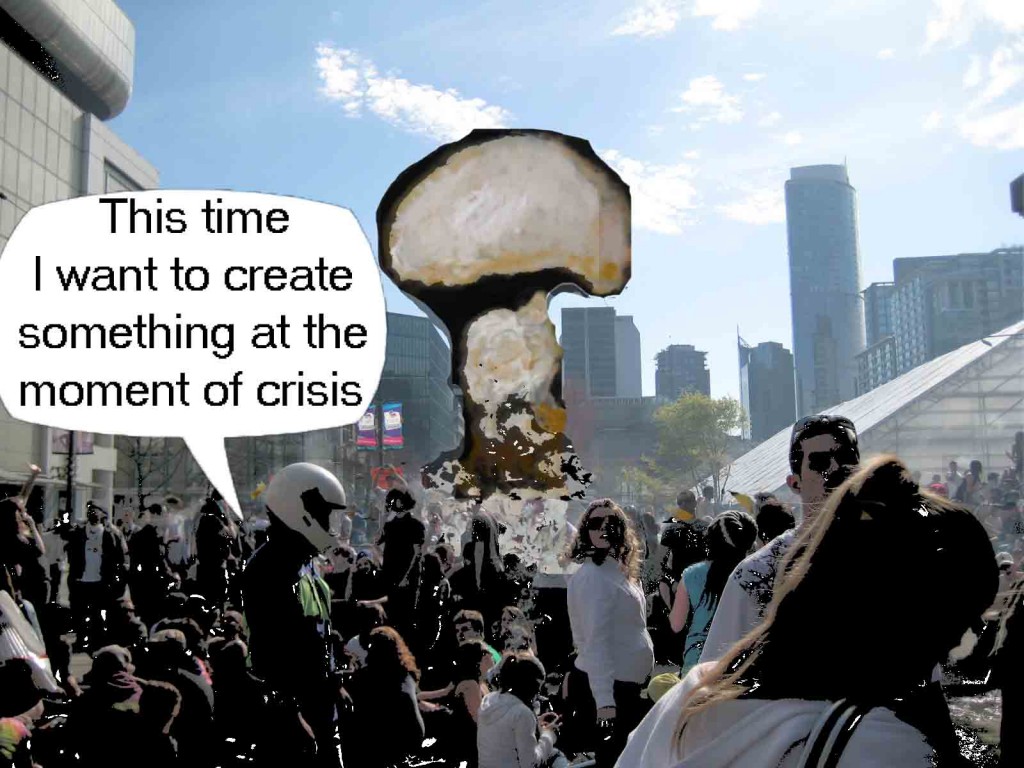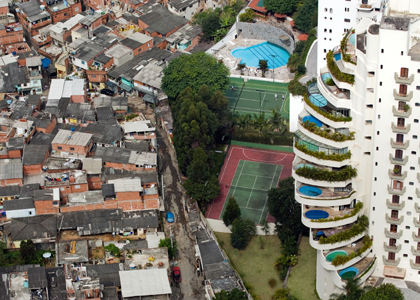P.S. – The writing component is not part of the post.
Author Archives: George Rahi
the right to the city: a cry … a demand
“It is foolish to deny the role and power of objectifications, the capacity of things we create to return to us as so many forms of domination” (David Harvey, 7)
We are at the head of a long battle to place the ideals of human rights center-stage. The power of the state has been rescaled with the simultaneous rise of multi-lateral and transnational institutions (UN, EU, ect.) and decentralization of responsibility to the local level. In the wake of this rescaling, new political spaces have emerged. Appropriate to our contemporary urban age, the “right to the city” will be a defining force in future urban life: “the right to participate in the city as an ongoing work of creation, production, and negotiation” (Burke). –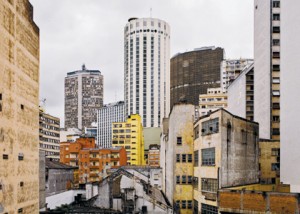 The city is the most expressive manifestation of the ever-present tendency to remake the world around us. In the words of Robert Park, “If the city is the world which man created, it is also the world in which he is henceforth condemned to live. Thus, indirectly, and without any clear sense of the nature of his task, in making the city man has remade himself” (23).
The city is the most expressive manifestation of the ever-present tendency to remake the world around us. In the words of Robert Park, “If the city is the world which man created, it is also the world in which he is henceforth condemned to live. Thus, indirectly, and without any clear sense of the nature of his task, in making the city man has remade himself” (23).
For David Harvey, the right to the city is therefore “far more than the individual liberty to access urban resources: it is a right to change ourselves by changing the city” (23). Our human experience is governed by a feedback loop between our activity and our material surroundings. The spaces we produce set powerful constraints upon future activity.
“Politics does not merely use the organization of space to its own ends. Politics is the organization of space” (Bertsch and Sterne). – The process of urbanization has been dictated primarily by the imperatives of growth, where city governments act as agents on behalf of capital. Characterized by a deal-making ethos, their actions appropriate and manipulate ideas regarding the definition of the public good and the objectives of the future city. The “right to the city” seeks to revise the city as not merely a site for the absorption of surplus capital, but as a space of humane cooperation, creativity, interaction, and affect. In its most basic definition, the right to the city is the right to urban livelihood with dignified and fair access to shelter, shared services, employment, and food security.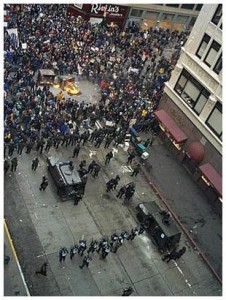 Reclaiming urban spaces is an attempt to assert this right. We saw it as protesters marched in the “no-protest zones” in Seattle of 1999, and we see it everyday when the homeless reclaim public spaces as police try to push them along (Vancouver’s Downtown Ambassadors now do this micro-policing on behalf of the private sector).
Reclaiming urban spaces is an attempt to assert this right. We saw it as protesters marched in the “no-protest zones” in Seattle of 1999, and we see it everyday when the homeless reclaim public spaces as police try to push them along (Vancouver’s Downtown Ambassadors now do this micro-policing on behalf of the private sector).
The city is a terrain of political struggle, as well as a site of possibility. The future cities we have examined all fracture across the possible outcomes of a struggle for the right to the city. How democratic is the utilization of the surplus created by the aspirations, ideologies, and labor of the collective? The picture is crystal clear in Metropolis as the bourgeoisie overlook the toil of the working class in the depths of the machine-city.
The situation in Bladerunner is less clear as the exodus of the city to space has left those behind in a eternal present of deterioration. The inhabitants of LA 2019 live in a hyper-commodified culture devoid of nature. It is unclear as to what are the major forces in the organization of urban life, which is perhaps what, in part, makes this dystopic portrayal so unsettling. The roots of this capitalist hell seem to lie in the voluntary reproduction of current trends (inaction-a failure to assert our right to the city).
The “right to the city” may be an overburdened concept, but it is an inherently utopic vision creating a space of potential.
Harvey D (2008) Right to the city. New Left Review 53: 23-40
Burke A (2005) Review of The Right to The City: Social Justic and the Fight for Public Space by Don Mitchell. http://www.h-net.org/reviews/showrev.php?id=10293
Manhunt, Shadowrun, and “They’re made out of meat”
The first game of manhunt in the newyear will be tomorrow (Wednesday) after class at 6:30. If you want to play, try and make it down to the front of Burrard Skytrain Station at 6:10.
 Also, I wanted to bring up the classic 1993 Super-nintendo game “Shadowrun” as its gameplay is very similar to Neuromancer. In the game you play as Jake Armitage, a mecernary who uses a Cyberdeck to hack into the matrices of corporations. You can hire other shadowrunners or henchmen to back you up as explore a decrepit Seattle filled with armed cyberpunk gangs. Similar to the “Necromancer” in Neuromancer, Shadowrun is filled with mystical/magical elements as the plot details a future where magic has returned to the world, and the opening scene in the game is your character being assasinated in the street then revieved from the dead by a shapeshifting lupine figure. Anyway, now that I think about it, I can’t believe I spent a portion of my childhood playing this wacked out game! Its seriously awesome…
Also, I wanted to bring up the classic 1993 Super-nintendo game “Shadowrun” as its gameplay is very similar to Neuromancer. In the game you play as Jake Armitage, a mecernary who uses a Cyberdeck to hack into the matrices of corporations. You can hire other shadowrunners or henchmen to back you up as explore a decrepit Seattle filled with armed cyberpunk gangs. Similar to the “Necromancer” in Neuromancer, Shadowrun is filled with mystical/magical elements as the plot details a future where magic has returned to the world, and the opening scene in the game is your character being assasinated in the street then revieved from the dead by a shapeshifting lupine figure. Anyway, now that I think about it, I can’t believe I spent a portion of my childhood playing this wacked out game! Its seriously awesome…
Oh, and heres that youtube video “They’re made out of meat” (an adapatation of the Terry Bisson shortstory) that was brought up when we were discussing the notion of post-humanism and the name “Case” in Neuromancer.
The cyborg city and the indeterminancy of the human subject
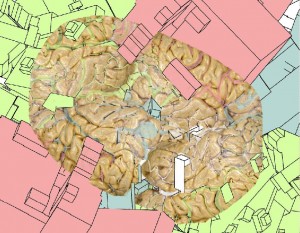 In Ballard’s novel High-Rise, he writes, “She referred to the high-rise as if it were some kind of huge animate presence, brooding over them and keeping a magisterial eye on the events taking place. There was something in this feeling — the elevators pumping up and down the long shafts resembled pistons in the chamber of a heart. The residents moving along the corridors were the cells in a network of arteries, the lights in their apartments the neurons of a brain” (1975, 40).
In Ballard’s novel High-Rise, he writes, “She referred to the high-rise as if it were some kind of huge animate presence, brooding over them and keeping a magisterial eye on the events taking place. There was something in this feeling — the elevators pumping up and down the long shafts resembled pistons in the chamber of a heart. The residents moving along the corridors were the cells in a network of arteries, the lights in their apartments the neurons of a brain” (1975, 40).
Ballard’s imagery dissolves the distinction between the interior/exterior and organic/inorganic. Mental and bodily inner-workings become superimposed upon the (built)landscape and vice-versa. This way of thinking about the contemporary human experience leads one directly to the concept of the cyborg. According to Donna Haraway, the cyborg is a hybrid creature “compounded of special kinds of machines and special kinds of organisms appropriate to the late twentieth century” (Gandy 27). In an age of “dematerialization … driven by the spread of informatics, increased capital mobility and the fracturing of place-bound identities”, the human experience has increasingly extended itself into new spaces of digital/virtual realms (Gandy 35).
The rapid co-evolution between social and technological systems produces new relationships with the built environment described as “cognitive scaffolding” and “distributed cognition”. Cognitive scaffolding refers to the short-cuts minds use when relying on the external environment to subsidize the processing of information; paper and pencil as external calculators, cellphones as memory, landmarks as distance signifiers, and subway color schemes as orientation devices. The concept of “distributed cognition” builds on these subsidizing mechanisms and represents a more radical environment where the boundaries between sentience and non-sentience is broken down as human agency becomes obscured by the myriad networks of information being processed by teams of organic/inorganic systems. On an individual level, such distributed cognition happens with the increasing prevalence of wearable computers, sensory augmentation, wireless devices, and thought-controlled prosthetics. At the urban scale, distributed cognition is exemplified in an early stage by characteristics of post-industrial global cities, where a traditional utilization of material exchange has become supplanted by the information exchange. The driving processes in cities such as New York, London, and Tokyo is the knowledge sector, composed of highly specialized services such as finance, insurance, real-estate, and law firms. Such cities are command points for the organization of the global economy and their very success depends on their extensive and autonomous integration with global markets in the form of digitized financial information.
Whats interesting to me is the uneven and patchwork nature of the trajectories of the urban/mind/tech hybrids. The wider landscape of material neglect and social polarization which characterize post-industrial urban spaces reveals the intrinsic social forces of unequal power relations, marginal spaces, violence, and social exclusion which shape the way urban and technological progress unfolds. This unevenness is important to note when exploring the suggestive tomorrows painted by techno-futurists, as the undifferentiated “we” of futurist urban literature overlooks the infrastructural crisis of a billion plus people living in slums. The cyborg concept produces useful insights into cities as components in a global-hierarchical information system and urban dwellers as technologically-enhanced urban citizens, and these insights should be seen as grounded in the geographical particularities of places. In this light, the cyborg concept helps illustrate “the hybridized socio-ecological relations that underpin the production of space” (Gandy 37). These hybridized relationships are producing vastly disparate spaces across the world, fostering unique trajectories in the evolution of the human psyche which may fracture across familiar socio-economic divides. The notion of a breakthrough in the body-technology nexus propelling humanity into a post-human realm becomes more of a question for who and where?
Works Cited:
Ballard, J.G. (1975) High-rise. Cape, London.
Gandy, Matthew (2005) “Cyborg Urbanization: Complexity and the Monstrosity in the Contemporary City”. International Journal of Urban and Regional Research Vol 29.1 (26-49)
The voluntary exhalations of late capitalism in Blade Runner
In an essay by William Timberman titled “The Future of Our Discontents“, he comments on the visual use of smoke in Blade Runner:
“almost everyone in Blade Runner smokes — the impenetrable tobacco haze is an important visual element in many of the interior scenes. It isn’t clear, in an age when smoking has become anathema, an almost universal symbol of dissipation and self-contempt, what Scott intends by giving it such pride of place in his version of the twenty-first century.
The answer, I think, is that the smoking in Blade Runner is intended as an echo, a reminder that all the poisonous exhalations of a capitalist society are voluntary. The fatal eroticism embodied in the fumes from Rachael’s smoldering cigarette is repeated in the orange skies above Los Angeles, in the continual dark rain which beats along its decaying rooftops and licks at the trash fires in its streets. Consumption pursued as an end in itself, Scott seems to be saying, will lead to the same, slow catastrophe whether it is an individual or an entire society which does the pursuing.”
In a book by David Pinder called Visions of the City:Utopianism, Power. and Politics , something he said about the role of utopianism in the imagination and perception of the city seemed related to the project of Sci-Fi futurism/urbanism in the stories we’ve looked at so-far.
For Pinder, to envision a utopia in an urban/spatial form works to disrupt the “seemingly inevitable reproduction of the present”. Envisioning is about “developing projects, events, situations and struggles through which other possibilities become more tangible and what is revealed as truly absurd is the claim, not that there are alternatives to be won, but that there aren’t any. Isn’t that the really shocking proposal, that this is it?”.
I thought it was interesting how the role of smoking in the L.A. of 2019 also creates this sense of possibility and choice in the movie’s depiction of what may come out of the actual reproduction of present trends. (Trends such as hyper-globalization with no clear direction, coupled with the persistence of uncertainty so inherent in the human experience).
